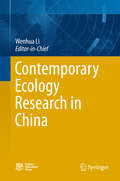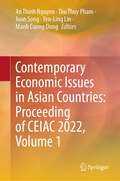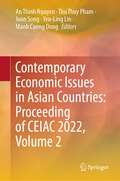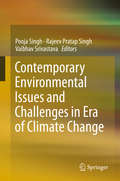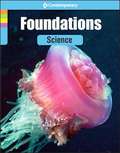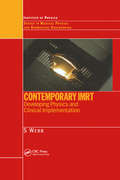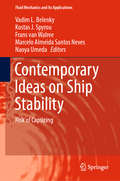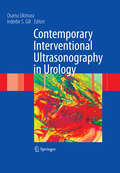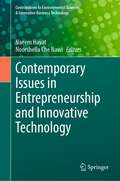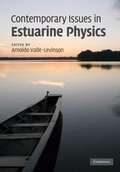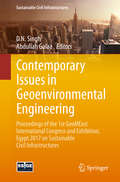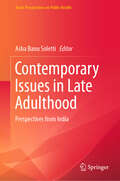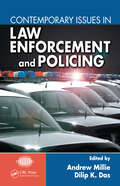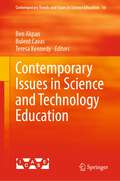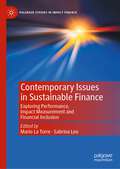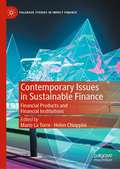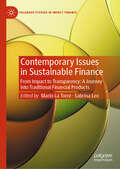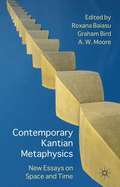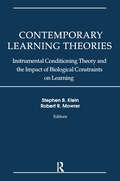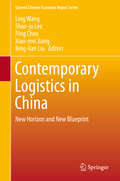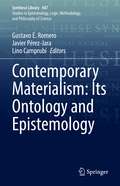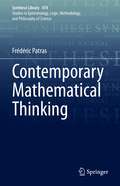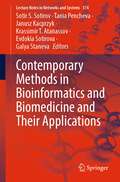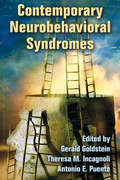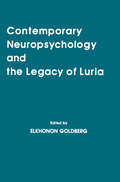- Table View
- List View
Contemporary Ecology Research in China
by Wenhua LiThe Chinese government is increasingly focusing on ecological construction and has subscribed to a national "Ecological Civilization Construction". Ecological research and protection practice develop so fast and achieve a lot at the national agenda. This book is a synthesis of five most exciting and dominant themes in contemporary ecological research in China: biodiversity, ecosystem management, degraded ecosystem restoration, global change and sustainable development. This book spans all the Earth's major ecosystems, such as forests, oceans, grasslands, wetlands, lakes, rivers, farmland and cities. This book provides a platform for scientific research across a variety of disciplines. It will be invaluable to experts, policymakers and local officers and will also be a highly useful resource for undergraduate and postgraduate students. This book will allow researchers, students and policymakers outside China to learn abou t the significant achievements and applications of ecological research within China.
Contemporary Economic Issues in Asian Countries: Proceeding of CEIAC 2022, Volume 1
by An Thinh Nguyen Thu Thuy Pham Joon Song Yen-Ling Lin Manh Cuong DongThis book makes general considerations regarding global changes and contemporary economic issues in Asian countries in real terms. It offers a collection of original conference papers from the annual international conferences on “Contemporary economic issues in Asian countries” (CEIAC Conference) commenced in 2022 in collaboration with CIFOR-ICRAF, Sungkyunkwan University (Korea), and Tamkang University (Taiwan). The theme of the CEIAC Conference 2022 deals with broad aspects of the contemporary economic issues in Asian countries. It covers topics such as economics and business (economic theory, national and international income distribution, macroeconomic policies, sectors of economy, productivity developments, financial market, business governance, bank financing, etc.), green economy and sustainable development (developing process, development policy, public policy, sustainable growth, green growth, etc.), and international trade and investment (international trade theory, free trade agreements, tariffs, intellectual property, international law, etc.). The book would interest a wide array of professors, researchers, lecturers, students in fields of economics, consultants, and decision makers interested in the issues related to economic issues in Asia.
Contemporary Economic Issues in Asian Countries: Proceeding of CEIAC 2022, Volume 2
by An Thinh Nguyen Thu Thuy Pham Joon Song Yen-Ling Lin Manh Cuong DongThis book continues the discussion from Volume 1 on the general considerations regarding global changes and contemporary economic issues in Asian countries in real terms. It offers a collection of original conference papers from the annual international conferences on “Contemporary economic issues in Asian countries” (CEIAC Conference) commenced in 2022 in collaboration with CIFOR-ICRAF, Sungkyunkwan University (Korea), and Tamkang University (Taiwan). The theme of the CEIAC Conference 2022 deals with broad aspects of the contemporary economic issues in Asian countries. It covers topics such as economics and business (economic theory, national and international income distribution, macroeconomic policies, sectors of economy, productivity developments, financial market, business governance, bank financing, etc.), green economy and sustainable development (developing process, development policy, public policy, sustainable growth, green growth, etc.), and international trade and investment (international trade theory, free trade agreements, tariffs, intellectual property, international law, etc.). The book would interest a wide array of professors, researchers, lecturers, students in fields of economics, consultants, and decision makers interested in the issues related to economic issues in Asia.
Contemporary Environmental Issues and Challenges in Era of Climate Change
by Rajeev Pratap Singh Pooja Singh Vaibhav SrivastavaOver the last few decades, unprecedented global population growth has led to increased demand for food and shelter. At the same time, extraction of natural resources beyond the Earth’s resilience capacity has had a devastating effect on ecosystems and environmental health. Furthermore, climate change is having a significant impact in a number of areas, including the global hydrological cycle, ecosystem functioning, coastal vulnerability, forest ecology, food security, and agricultural sustainability. According to the Intergovernmental Panel on Climate Change (IPCC), only immediate and sustained action will prevent climate change causing irreversible and potentially catastrophic damage to our environment. This book presents various scientific views and concepts, research, reviews, and case studies on contemporary environmental issues in changing climate scenarios and highlights different adaptation measures. Increasing awareness of modern-day patterns of climate change, it addresses questions often raised by environmental scientists, researchers, policymakers and general readers.
Contemporary Foundations: Science
by Wright Group/McGraw-HillContemporary's Foundations series helps students improve their basic skills. Each book provides skill instruction, offers interesting passages to study, and furnishes opportunities for practice.Foundations provides meaningful contexts for learning, using language which is easy to understand. About Foundations: Science, Revised Edition : In Foundations: Science, students will learn about the human body, plant biology, physics, chemistry, and Earth science. They will practice putting events in order; reading diagrams, charts, and graphs; using the scientific method; and making comparisons and contrasts. Try It yourself! activities will guide students through simple experiments so they will have a better understanding of what they have been reading about.Writing Workshops and Language Tips will help students use their reading and writing skills to think about science topics. About the Series: In Foundations: Reading, students will read practical information, nonfiction, poetry, and short stories. They will learn to find the main point and the details; identify fact, opinion, and bias; make inferences; read photographs and cartoons; and understand rhythm, rhyme, plot, and theme. Writing Workshops, Language Tips, and prereading questions are designed to improve reading, writing, and thinking skills. In Foundations: Writing, students will practice the four steps to writing an essay: prewriting, drafting, revising, and editing. They will read and write five kinds of essays: descriptive essays, personal narratives, how-to essays, essays of example, and comparison-and-contrast essays. A language-skills workbook provides grammar, punctuation, and sentence structure practice. In Your Journal, With a Partner, and Language Tips will help students become better writers, and better readers and thinkers as well. In Foundations: Science, students will learn about the human body, plant biology, physics, chemistry, and Earth science. They will practice putting events in order; reading diagrams, charts, and graphs; using the scientific method; and making comparisons and contrasts. Try It yourself! activities will guide students through simple experiments so they will have a better understanding of what they have been reading about. Writing Workshops and Language Tips will help students use their reading and writing skills to think about science topics. In Foundations: Social Studies, students will learn about world history, U.S. history, civics and government, geography, and economics. They will summarize, make predictions, infer the main idea of cartoons, find information on maps, and read various kinds of graphs. Background Information, Language Tips, and Writing Workshops will let students use what they already know as they read and write about social studies topics. The revised edition includes a new World History chapter. In Foundations: Math, students will practice using whole numbers, money, decimals, fractions, ratios, and percents. Exercises will help students review the addition, subtraction, multiplication, and division facts; round numbers; estimate answers; and solve word problems. Math Notes, On their Calculator, and Language Tips will help students improve math skills. The revised edition of Math is a major revision. The language has been updated to make the material even easier to follow than before.
Contemporary IMRT: Developing Physics and Clinical Implementation (Series in Medical Physics and Biomedical Engineering)
by S. WebbThe most important radiotherapy modality used today, intensity modulated radiation therapy (IMRT), is the most technologically advanced radiotherapy cancer treatment available, rapidly replacing conformal and three-dimensional techniques. Because of these changes, oncologists and radiotherapists need up-to-date information gathered by physicists an
Contemporary Ideas on Ship Stability: Risk of Capsizing (Fluid Mechanics and Its Applications #119)
by Vadim L. Belenky Kostas J. Spyrou Frans Van Walree Marcelo Almeida Santos Neves Naoya UmedaThis book contains a selection of research papers presented at the 11th and 12th International Ship Stability Workshops (Wageningen, 2010 and Washington DC, 2011) and the 11th International Conference on Stability of Ships and Ocean Vehicles (Athens, 2012). The book is directed toward the ship stability community and presents innovative ideas concerning the understanding of the physical nature of stability failures and methodologies for assessing ship stability. Particular interest of the readership is expected in relation with appearance of new and unconventional types of ships; assessment of stability of these ships cannot rely on the existing experience and has to be based on the first principles. As the complexity of the physical processes responsible for stability failure have increasingly made time-domain numerical simulation the main tool for stability assessment, particular emphasis is made on the development an application of such tools. The included papers have been selected by the editorial committee and have gone through an additional review process, with at least two reviewers allocated for each. Many of the papers have been significantly updated or expanded from their original version, in order to best reflect the state of knowledge concerning stability at the time of the book’s publication. The book consist of four parts: Mathematical Model of Ship Motions in Waves, Dynamics of Large Motions, Experimental Research and Requirements, Regulations and Operations.
Contemporary Interventional Ultrasonography in Urology
by Inderbir S. Gill Osamu UkimuraExciting new developments and applications of imaging techniques have emerged over the last few years, leading to many improvements in diagnosis and staging of urologic diseases. Refinements in the technology mean that imaging now is much more precise than even five years ago, and this has significantly enhanced its application within several key fields. As such, there are virtually no books currently available that cover the impact of these advances within urology leaving a major hole in the market. With its sound overview of the current state of affairs, and also its focus on highlighting future advances, this book would therefore find a significant audience within not only trainees, but also practicing clinicians too. Furthermore, the whole topic of ultrasonography is a relatively overlooked one, with very few modern books tackling any specific areas of the field. This book will be up-to-date and will pay attention to the unique applications of ultrasound within each discipline.
Contemporary Issues in Entrepreneurship and Innovative Technology (Contributions to Environmental Sciences & Innovative Business Technology)
by Naeem Hayat Noorshella Che NawiThe book offers state-of-the-art information in the field of entrepreneurship, business management, the role of technology to manage entrepreneurial firms, and innovation and social aspects of firms. The book also offers quality research with quantitative and qualitative designs offering insights into the emerging business trends among the entrepreneurial firms. The volume supports early career researchers and students looking for research acumen in small business and entrepreneurship.
Contemporary Issues in Estuarine Physics
by A. Valle-LevinsonEstuaries are of high socioeconomic importance with 22 of the 32 largest cities in the world located on river estuaries. Estuaries bring together fluxes of fresh and saline water, as well as fluvial and marine sediments, and contain high biological diversity. Increasingly sophisticated field observation technology and numerical modeling have produced significant advances in our understanding of the physical properties of estuaries over the last decade. This book introduces a classification for estuaries before presenting the basic physics and hydrodynamics of estuarine circulation and the various factors that modify it in time and space. It then covers special topics at the forefront of research such as turbulence, fronts in estuaries and continental shelves, low inflow estuaries, and implications of estuarine transport for water quality. Written by leading authorities on estuarine and lagoon hydrodynamics, this volume provides a concise foundation for academic researchers, advanced students and coastal resource managers.
Contemporary Issues in Geoenvironmental Engineering: Proceedings of the 1st GeoMEast International Congress and Exhibition, Egypt 2017 on Sustainable Civil Infrastructures (Sustainable Civil Infrastructures)
by D N Singh Abdullah GalaaWith high urbanization rates, advancement in technologies, and changes in consumption behavior of people, wastes generated through the daily activities of individuals and organizations pose many challenges in their management. The articles presented in this edited volume deal with the attempts made by the scientists and practitioners to address contemporary issues in geoenvironmental engineering such as characterization of dredged sediments, geomaterials & waste, valorization of waste, sustainability in waste management and some other geoenvironmental issues that are becoming quite relevant in today's world. This volume is part of the proceedings of the 1st GeoMEast International Congress and Exhibition on Sustainable Civil Infrastructures, Egypt 2017.
Contemporary Issues in Late Adulthood: Perspectives from India (Asian Perspectives on Public Health)
by Asha Banu SolettiThis book provides an in-depth exploration of the challenges and diversity inherent in the ageing process in India. It offers valuable insights into various aspects of growing old, covering a spectrum of issues influenced by socioeconomic inequalities and diversities that shape the lives of older adults. Despite existing research on aging, there's often a tendency to overlook the diverse experiences within the older population, a gap this book aims to bridge. The chapters of the book, are written by practitioners and academicians, sharing their insights on the issue. The book adopts a multidisciplinary approach, drawing on contributions from a diverse array of experts to comprehensively address the myriad issues affecting late adulthood. From mental health and nutrition to gender dynamics, income security, elder abuse, and intergenerational concerns, each topic is explored. A central theme of the book is the importance of recognizing and addressing the unique challenges faced by different groups within the elderly population. . By synthesizing insights from different fields, the book offers a comprehensive examination of the challenges encountered by older adults across multiple dimensions of their lives. This interdisciplinary perspective enriches the discourse on ageing and provides practical insights for researchers, practitioners, policymakers, and anyone interested in advocating for the well-being of ageing populations.
Contemporary Issues in Law Enforcement and Policing (International Police Executive Symposium Co-Publications)
by Dilip K. Das Andrew MillieRising terrorism and advances in technology, along with new organizational strategies and investigative techniques, have stretched the traditional role of the police officer. Calls for strong, intelligence-driven, paramilitary policing juxtaposed with a demand for ‘softer community policing, leave officers under increased pressure to be tough and
Contemporary Issues in Science and Technology Education (Contemporary Trends and Issues in Science Education #56)
by Teresa Kennedy Ben Akpan Bulent CavasThis edited volume discusses major issues in present-day science and technology education (STE). It is divided into three thematic sections: philosophical foundations and curriculum development; sustainable development, technology and society; and the learning sciences and 21st century skills. Section I examines the history and future of STE curriculum development, along with specific issues within this dynamic area. Section II explores sustainable development in three important aspects: economic development, social development, and environmental protection. Section III covers the 21st century skills that are of overarching importance to the success of learners in school and the world of work. Anchoring each chapter is an assemblage of veteran science and technology education specialists selected from across the world. The book’s target is a worldwide audience of undergraduate / post-graduate students and their teachers, as well as researchers. This book’s exploration of the ever-increasing advances in STE and its narrative writing style will be of interest to a broad range of readers.
Contemporary Issues in Sustainable Finance: Exploring Performance, Impact Measurement and Financial Inclusion (Palgrave Studies in Impact Finance)
by Mario La Torre Sabrina LeoThe notion of sustainable development is applied to financial activities through sustainable finance. As a result, sustainable finance attempts to produce long-term value by allocating capital to projects that, in addition to providing economic benefits, are furthermore beneficial to society and do not burden the environment.This book sheds light on contemporary challenges in sustainable finance, addressing two key perspectives: measurement and performance, and products and business models. In particular, the volume examines theoretically and empirically the relations between business models and non-financial impact, both environmental and social; as for the social goals, a special focus of the book is dedicated to the gender gap.
Contemporary Issues in Sustainable Finance: Financial Products and Financial Institutions (Palgrave Studies in Impact Finance)
by Mario La Torre Helen ChiappiniThis book sheds light on current issues in sustainable finance through an in-depth analysis and discussion of relevant sustainable products and sustainable initiatives of several financial institutions. This edited collection critically presents and discusses several relevant theoretical issues, case studies of innovative financial products and sustainable institutions, as well as empirically investigates issues related to both financial and social performance. The book focuses on several innovative products across the sustainable finance ecosystem, including social impact bonds, crowdfunding and green bonds. Similarly, the book spotlights the sustainable investment strategies of institutions ranging from family foundations to asset managers.
Contemporary Issues in Sustainable Finance: From Impact to Transparency: a journey into traditional financial products (Palgrave Studies in Impact Finance)
by Mario La Torre Sabrina LeoThis book explores the evolving landscape of sustainable finance across various sectors and delves into critical topics ranging from the integration of Environmental, Social, and Governance (ESG) criteria in investment decisions to the transformative potential of blockchain technology. In more detail, three main perspectives are addressed: the issue of materiality and integrating ESG factors in the firm business model; the trends in the debt and credit markets; and the role of governance and transparency. In nine chapters, the book covers both a theoretical approach as well as empirical analysis, providing essential perspectives for regulators, investors, practitioners, and scholars navigating the complex landscape of sustainable finance.
Contemporary Kantian Metaphysics
by A. W. Moore Graham Bird Roxana BaiasuThis collectionresponds to two needs in the literature. First, the Kantian tradition of thought about space and time represents a rich philosophical resource, insufficiently explored in Anglo-American philosophy. The volume explores this resource. More precisely, it questions a basic assumption of a powerful trend in contemporary metaphysics: the assumption that reality is spatio-temporally organised independently of us. Kant's revolutionary contribution to metaphysics was likewise to question this assumption. The volume draws attention to Kant's distinctive approach to metaphysics and breaks new ground by radically broadening the scope of recent discussions on space and time, in particular by examining certain connections which metaphysics and science have to epistemic agency. Second, contemporary Kantian philosophy is currently pursued along two lines of thinking developed in Anglo-American literature and European philosophy. This work brings their distinct claims into a productive dialogue on topical issues such as action, perception, the body, and cognition and its limits.
Contemporary Learning Theories: Volume II: Instrumental Conditioning Theory and the Impact of Biological Constraints on Learning
by Stephen B. Klein Robert R. MowrerThis unique two-volume set provides detailed coverage of contemporary learning theory. Uniting leading experts in modern behavioral theory, these texts give students a complete view of the field. Volume I details the complexities of Pavlovian conditioning and describes the current status of traditional learning theories. Volume II discusses several important facets of instrumental conditioning and presents comprehensive coverage of the role of inheritance on learning. A strong and complete base of knowledge concerning learning theories, these volumes are ideal reference sources for advanced students and professionals in experimental psychology, learning and learning theory, and comparative physiology.
Contemporary Logistics in China: New Horizon and New Blueprint (Current Chinese Economic Report Series)
by Bing-Lian Liu Ling Wang Shao-Ju Lee Ping Chen Xiao-Mei JiangThis book is the sixth volume in a series entitled "Contemporary Logistics in China," authored by researchers at the Logistics Center, Nankai University. In the spirit of the five preceding volumes, published annually in previous years, this book carries on the ideal of providing a systematic exposition on the development of logistics in China to the English-speaking community. Specifically, this volume captures China's logistics development at a crucial turning point. On the one hand, it echoes the new horizon advocated by the Government's One-Belt-One-Road Initiative for global cooperation; on the other, it resonates with the new blueprint of implementing the main contents of the 13th Five-year Plan on logistics development. Subjects covered include the macro-factors pertaining to logistics development, region-specific plans, industry-wide transformation, globally oriented moves, and current hot topics. Expositions and analyses on these subjects are based on the latest available sources and statistical data. As with the previous volumes, the ultimate aim of this book is to present a timely portrait of the rapid growth of China's logistics market and the status of its logistics industry's evolution. In so doing, this book offers an in-depth analysis of the critical issues and dilemmas amid the ongoing, dynamic and multi-faceted development, and presents a valuable reference source for interested readers in the academic and professional fields.
Contemporary Materialism: Its Ontology and Epistemology (Synthese Library #447)
by Lino Camprubí Gustavo E. Romero Javier Pérez-JaraThis book provides an up-to-date revision of materialism’s central tenets, its main varieties, and the place of materialistic philosophy vis a vis scientific knowledge.Materialism has been the subject of extensive and rich controversies since Robert Boyle introduced the term for the first time in the 17th century. But what is materialism and what can it offer today? The term is usually defined as the worldview according to which everything real is material. Nevertheless, there is no philosophical consensus about whether the meaning of matter can be enlarged beyond the physical. As a consequence, materialism is often defined in stark exclusive and reductionist terms: whatever exists is either physical or ontologically reducible to it. This conception, if consistent, mutilates reality, excluding the ontological significance of political, economic, sociocultural, anthropological and psychological realities. Starting from a new history of materialism, the present book focuses on the central ontological and epistemological debates aroused by today’s leading materialist approaches, including some little known to an anglophone readership. The key concepts of matter, system, emergence, space and time, life, mind, and software are checked over and updated. Controversial issues such as the nature of mathematics and the place of reductionism are also discussed from different materialist approaches. As a result, materialism emerges as a powerful, indispensable scientifically-supported worldview with a surprising wealth of nuances and possibilities.
Contemporary Mathematical Thinking (Synthese Library #474)
by Frédéric PatrasThis book deals with the evolution of mathematical thought during the 20th century. Representing a unique point of view combining mathematics, philosophy and history on this issue, it presents an original analysis of key authors, for example Bourbaki, Grothendieck and Husserl. As a product of 19th and early 20th century science, a canon of knowledge or a scientific ideology, mathematical structuralism had to give way. The succession is difficult, still in progress, and uncertain. To understand contemporary mathematics, its progressive liberation from the slogans of "modern mathematics" and the paths that remain open today, it is first necessary to deconstruct the history of this long dominant current. Another conception of mathematical thought emerged in the work of mathematicians such as Hilbert or Weyl, which went beyond the narrow epistemological paths of science in the making. In this tradition, mathematical thought was accompanied by a philosophical requirement. Modernity teaches us to revive it. The book is intended for a varied public: mathematicians concerned with understanding their discipline, philosophers of science, and the erudite public curious about the progress of mathematics.
Contemporary Methods in Bioinformatics and Biomedicine and Their Applications (Lecture Notes in Networks and Systems #374)
by Krassimir T. Atanassov Janusz Kacprzyk Evdokia Sotirova Sotir S. Sotirov Tania Pencheva Galya StanevaThis book gathers selected papers from the First International Symposium on Bioinformatics and Biomedicine. Issues related to medicine and health care constitute one of the grand challenges faces by the mankind, and this naturally implies a growing interest in these problems among both researchers and scholars, politicians and policymakers, as well as economist. The present values which gather selected papers from the First International Symposium on Bioinformatics and Biomedicine (BioInfoMed’2020) is a recent response to this interests. In the subsequent sections and chapters, it covers a multitude of various topics related to bioinformatics, biomedicine, bioenginering, as well as a broadly perceives healthcare. Issues related to decision making in bioinformatics, biomedicine and health care, mathematical modelling in biomedicine and health care, artificial intelligence in biomedicine and health care, uncertainty and imprecision, notably intuitionistic fuzzy sets with applications in bioinformatics and biomedicine, biomedical approaches and applications, biomedical imaging and image processing, and excitable structures and motor activity are covered.
Contemporary Neurobehavioral Syndromes
by Gerald Goldstein Theresa M. Incagnoli Antonio E. PuenteDuring the twentieth century, new neurobehavioral diseases appeared or were described for the first time. Exposure to certain toxins or noxious environments, for example, produced illnesses that did not exist before the twentieth century. In addition, established illnesses were reconceptualized with regard to their cause or neurobiological basis. Autism, for instance, was described for the first time during the twentieth century and may not have existed previously. Its cause was subsequently reconceptualized from a disorder related to inadequate parenting, to a brain disorder with possible genetic causes. These major new and reconceptualized disorders are reviewed in this book with regard to their neurocognitive characteristics, causes, and outcome. Disorders covered include ADHD in adults, Lewy Body Dementia, autism, multiple chemical sensitivity, deployment syndromes found in veterans of the Persian Gulf and Afghanistan wars, effects of low birth weight, neurobehavioral respiratory disorders, PTSD, and comorbid disorders such as depression and brain injury. The expert reviews of these disorders give balanced coverage of the ongoing and often controversial research findings that continue to generate much professional and public interest. This volume provides an essential resource for researchers, instructors, and clinicians in the fields of neuropsychology, psychiatry, behavioral neurology, neuroscience, toxicology, as well as the informed general public concerned and affected by these disorders.
Contemporary Neuropsychology and the Legacy of Luria (Institute for Research in Behavioral Neuroscience Series)
by Elkhonon GoldbergBest known as a founding father of neuropsychology, Luria is remembered for his clinical approach, which in many ways foreshadowed and served as the basis for the currently popular "process approach" to neuropsychological diagnosis. Although he never completed the job of designing a general theory of brain- behavioral relations, he nonetheless contributed mightily to the ongoing effort to develop one, and to the emergence of neuropsychology as a mature science. Written by professionals who either knew Alexandr Romanovich Luria personally or experienced his scientific influence, the topics examined in this volume reflect the expanse of his interests and contributions.
